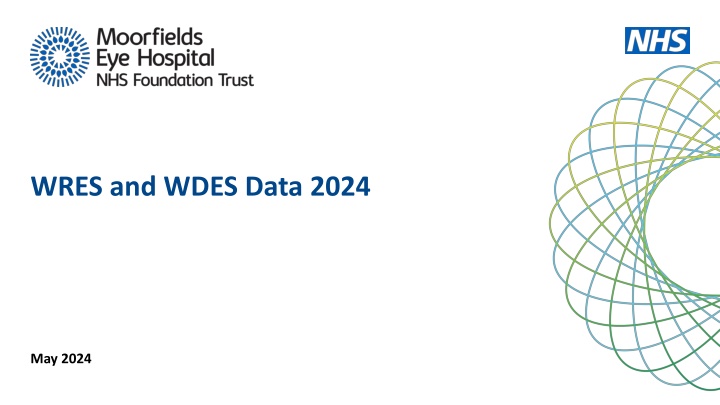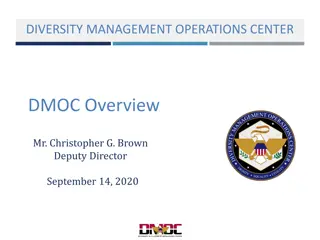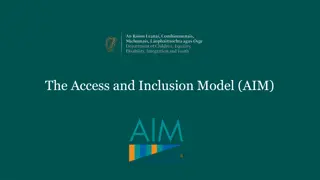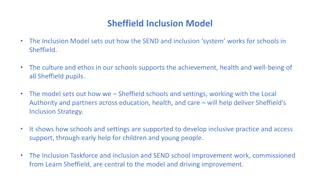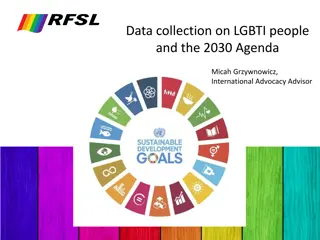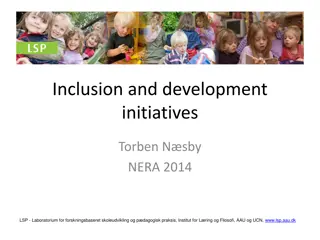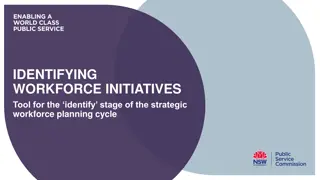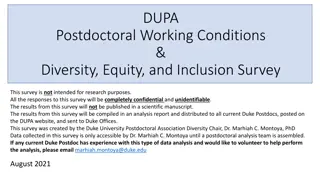Diversity and Inclusion Insights in Workforce Data 2024
Explore the Workforce Race Equality Standard (WRES) and Workforce Disability Equality Standard (WDES) data for May 2024. The data provides insights into workforce diversity, representation, likelihood of appointments, disciplinary processes, training access, harassment experiences, and more, with a focus on comparing outcomes for BME and white staff members. Discover the challenges and progress in promoting equality and inclusion within the organization.
Download Presentation

Please find below an Image/Link to download the presentation.
The content on the website is provided AS IS for your information and personal use only. It may not be sold, licensed, or shared on other websites without obtaining consent from the author.If you encounter any issues during the download, it is possible that the publisher has removed the file from their server.
You are allowed to download the files provided on this website for personal or commercial use, subject to the condition that they are used lawfully. All files are the property of their respective owners.
The content on the website is provided AS IS for your information and personal use only. It may not be sold, licensed, or shared on other websites without obtaining consent from the author.
E N D
Presentation Transcript
WRES and WDES Data 2024 May 2024
Content Workforce Race Equality Standard Data and insights Workforce Disability Equality Standard - Data and insights
Our data WRES National MEH WRES Indicator 2020 2021 2022 2023 2020 2021 2022 2023 2024 Overall 21.0% 22.4% 24.2% 26.4% 52.6% 53.0% 54.4% 55.9% 57.6% 1Percentage of BME staff VSM 6.8% 9.2% 10.3% 11.2% 0.0% 0.0% 0.0% 0.0% 2 Relative likelihood of white applicants being appointed from shortlisting across all posts compared to BME applicants 1.61 1.61 1.54 1.59 1.26 1.24 1.38 1.21 1.47 3 Relative likelihood of BME staff entering the formal disciplinary process compared to white staff 1.16 1.14 1.14 1.03 1.19 0.91 0.76 0.98 0.76 4 Relative likelihood of white staff accessing non-mandatory training and CPD compared to BME staff 1.14 1.14 1.12 1.12 1.22 0.73 1.11 0.85 1.4 BME 30.3% 28.9% 29.2% 30.5% 28.3% 29.2% 29.4% 31.8% 25.5% 5Percentage of staff experiencing harassment, bullying or abuse from patients, relatives or the public in the last 12months White 27.9% 25.9% 27.0% 26.9% 22.6% 23.6% 26.5% 23.1% 23.0% BME 28.4% 28.8% 27.6% 27.5% 28.5% 31.5% 31.8% 32.5% 30.4% 6Percentage of staff experiencing harassment, bullying or abuse from staff in last 12months White 23.6% 23.2% 22.5% 21.7% 22.5% 24.9% 25.4% 25.6% 26.1% BME 45.6% 44.0% 44.4% 46.7% 48.2% 45.3% 41.7% 41.7% 42.2% 7Percentage of staff believing that trust provides equal opportunities for career progression or promotion White 59.7% 59.6% 58.7% 59.4% 57.1% 56.4% 56.1% 54.4% 49.7% BME 14.5% 16.7% 17.0% 16.4% 12.5% 15.6% 17.3% 17.6% 17.0% 8Percentage of staff personally experiencing discrimination at work from a manager/team leader of other colleagues White 6.0% 6.2% 6.8% 6.6% 13.4% 7.8% 8.2% 8.9% 10.2% 9BME board membership 10.0% 12.6% 13.2% 15.6% 15.0% 15.0% 10.0% 10.0% 5.6%
Our data WRES insights Indicator 1 representation Our position remains stable YoY and we are outperforming the national data, as might be expected for a London-based Trust. However, given our higher representation, it is disappointing to note that this position worsens the more senior you get in the organisation, with some exceptions. Indicator 2 - relative likelihood of a white colleague being appointed from Shortlisting The position compared to last year has worsened.
Our data - WRES insights Indicator 3 - relative likelihood of BME staff entering formal disciplinary The data here improved, meaning BME colleagues are no more likely to enter formal disciplinary process when compared with white colleagues. Indicator 4 - CPD and non mandatory training This ratio has worsened compared to last year, meaning BME compared to white colleagues don t have equity in accessing CPD.
Our data - WRES insights Indicator 5-8 - staff survey Incidences of Bullying, Harassment and abuse is lower compared to last year for our BME colleagues. Trust in the provision of equal opportunities for career progression and promotion is lower amongst our BME colleagues, with the Trust position slightly worse than the national data. Compare to last year the data has slightly improved. Indicator 9 - Board representation Board representation has worsened compared to last year and 10% below the national picture. However, this is driven by a BME non-executive director leaving the Trust.
Our data WDES Indicator 1-5 National MEH WDES Indicator 2020 2021 2022 2023 2020 2021 2022 2023 2024 Disabled 3.4% 3.7% 4.2% 4.90% 2.0% 2.2% 2.2% 2.7% 3.1% 1Representation Non-Disabled 73.5% 74.9% 90.4% 93.2% 93.7% 91.3% 89.2% 2Relative likelihood of non-disabled applicants being appointed from shortlisting across all posts compared to disabled applicants 0.99 1.31 1.5 1.7 1.3 3.3 1.2 1.1 1.1 Statistically not able to determine Statistically not able to determine 3Relative likelihood of disabled staff entering the formal capability process compared to non disabled staff 2.17% 43.34 17.1 1.54 1.94 2.01 42.9 4aPercentage of disabled staff experiencing harassment, bullying or abuse from: Disabled 33.8% 31.6% 33.0% 33.20% 35.2% 38.2% 37.8% 33.5% 32.4% 4 Patients/Service users, their relatives or other members of the public Non-Disabled 26.8% 25.2% 25.7% 26% 24.2% 24.9% 26.2% 27.3% 23.2% Disabled 19.8% 18.6% 17.0% 16.10% 26.1% 28.0% 28.3% 21.4% 28.1% 4 Managers Non-Disabled 13.0% 10.7% 9.6% 9.20% 13.8% 15.0% 14.7% 13.9% 13.5% Disabled 26.8% 25.7% 25.0% 24.80% 33.6% 33.6% 35.8% 30.9% 32.9% 4 Other colleagues Non-Disabled 18.1% 16.8% 16.4% 16.50% 21.6% 20.9% 22.6% 22.4% 20.8% Percentage of Disabled staff compared to non-disabled staff saying that the last time they experienced harassment, bullying or abuse at work, they or a colleague reported it. Disabled 47.8% 49.6% 49.9% 51.30% 56.7% 55.3% 57.9% 53.6% 43.3% 4b Non-Disabled 46.6% 48.0% 48.6% 49.50% 48.4% 50.7% 54.6% 52.8% 52.8% Disabled 51.9% 51.5% 51.3% 52.10% 40.6% 42.8% 40.1% 49.7% 36.8% 5Percentage of staff believing that trust provides equal opportunities for career progression or promotion Non-Disabled 58.0% 57.6% 57.2% 57.70% 53.4% 50.8% 48.8% 46.3% 47.1% NB: Please note that National Data for 2023/2024 has not yet been published
Our data WDES Indicators 6-10 Disabled 32.0% 31.3% 29.9% 27.70% 36.4% 39.0% 42.7% 35.4% 37.5% 6Percentage of Disabled staff compared to non-disabled staff saying that they have felt pressure from their manager to come to work, despite not feeling well enough to perform their duties. Non-Disabled 23.0% 23.0% 22.1% 19.90% 22.3% 27.4% 28.4% 26.7% 24.6% Disabled 37.2% 39.2% 35.1% 35.20% 45.5% 51.3% 36.6% 33.5% 31.9% 7Percentage of Disabled staff compared to non-disabled staff saying that they are satisfied with the extent to which their organisation values their work. Non-Disabled 47.9% 50.5% 44.9% 45% 53.6% 56.5% 48.3% 46.7% 50.3% 8Percentage of Disabled staff saying that their employer has made adequate adjustment(s) to enable them to carry out their work. 72.4% 76.6% 72.2% 73.40% 66.3% 66.3% 62.5% 64.8% 61.4% Disabled 6.60 6.70 6.50 6.4 7.10 7.00 6.5 6.6 6.5 9aThe staff engagement score for Disabled staff, compared to non- disabled staff. Non-Disabled 7.10 7.20 7.00 6.9 7.40 7.40 7.2 7.2 7.2 9bHas your Trust taken action to facilitate the voices of Disabled staff in your organisation to be heard? Yes/No 92.80%NK 99.50% 100%Yes Yes Yes Yes Yes Disabled - Voting 2.80% 3.60% 0.0% 6% 6.3% 0.0% 0.0% Disabled - Non 3.80% 3.90% 0.0% 0% 20.0% 20.0% 0.0% 10 Board representation 4.60% Disabled - Exec 3.30% 3.80% 0.0% 0% 8.3% 9.1% 0.0% Disabled - NED 2.70% 3.60% 5.70% 0.0% 11% 11.1% 0.0% 0.0% NB: Please note that National Data for 2023/2024 has not yet been published
Our data WDES insights Indicator 1 representation Our position has marginally improved Year on Year (YoY), we remain behind the national average. Numbers are small and representation is therefore fragile. Staff Survey data indicates 16.02% of respondents (circa 225 colleagues) have a long term condition or disability, suggesting colleagues are under declaring on ESR (78 declared on ESR). Indicator 2 - relative likelihood of non disabled candidates being appointed Our position has worsened since last year, and we will be putting actions in place.
Our data WDES insights Indicator 3 - relative likelihood of disabled colleagues entering formal capability Due to the small numbers, the data cannot be reported on. In line with revised reporting requirements, where trusts report less than 10 cases, the indicator is redacted for the purposes of public reporting. Indicator 4-9a - staff survey data Reports of Bullying, Harassment or abuse are higher for disabled colleagues than non-disabled colleagues, although Trust results are broadly in line with the national data for 2023.
Our data - WDES insights Indicator 4-9a - staff survey data Disabled colleagues report lower levels of trust regarding equal opportunity for career progression or promotion, compared to last year this has decreased. Disabled colleagues are less likely to report feeling satisfied by the extent that their work is valued, and this has worsened YoY, bringing the Trust position lower than the national picture. Adequate reasonable adjustments reported as being in place has decreased, although still 12% points lower for the Trust than national data There remains a difference between Engagement scores for disabled versus non- disabled colleagues, in line with the national picture
Our data - WDES insights Indicator 9b employee voice Endorsed by the MoorAbilityStaff Network we were able to state that we have taken action to facilitate the voice of disabled colleagues most evident in our work on Leadership Academy Programme and Reasonable Adjustments Guidance. We also have conducted qualitative survey to get insights to understand the lived experience of those working with a disability at MEH and to review staff survey and WDES results with qualitative data. Indicator 10 Board representation This has not improved compared to last year. Our representation here has not improved.
